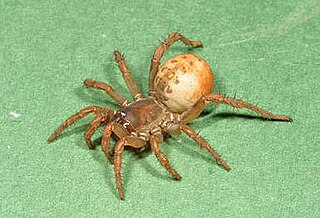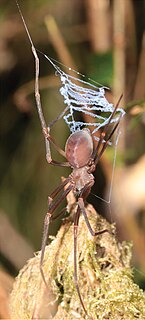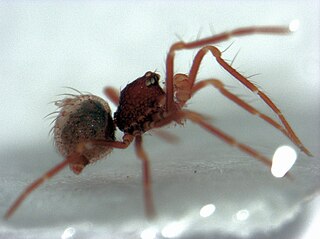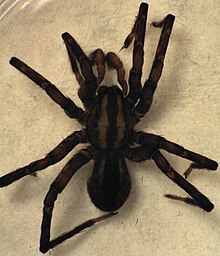
The Mesothelae are a suborder of spiders that includes a single extant family, Liphistiidae, and a number of extinct families. This suborder is thought to form the sister group to all other living spiders, and to retain ancestral characters, such as a segmented abdomen with spinnerets in the middle and two pairs of book lungs. Members of Liphistiidae are medium to large spiders with eight eyes grouped on a tubercle. They are found only in China, Japan, and southeast Asia.

Lampshade spiders, family Hypochilidae, are among the most primitive of araneomorph spiders. There are two genera and twelve species currently recognized. Like mygalomorphs, most hypochilids have two pairs of book lungs, but like araneomorphs they have intersecting fangs, with the exception of some species which have chelicerae in an angle that is neither orthognathous or labidognathous. These long-legged spiders build typical "lampshade" style webs under overhangs and in caves. In the United States the fauna is primarily associated with the Appalachian, Rocky and California Mountains. Ten of the known species are found in these ranges, all in the genus Hypochilus. The genus Ectatosticta is found in China.

Spider taxonomy is that part of taxonomy that is concerned with the science of naming, defining and classifying all spiders, members of the Araneae order of the arthropod class Arachnida with about 46,000 described species. However, there are likely many species that have escaped the human eye to this day, and many specimens stored in collections waiting to be described and classified. It is estimated that only one third to one half of the total number of existing species have been described.

Norman Ira Platnick was an American biological systematist and arachnologist. At the time of his death, he was a Professor Emeritus of the Richard Gilder Graduate School and Peter J. Solomon Family Curator Emeritus of the invertebrate zoology department of the American Museum of Natural History. A 1973 Ph.D. recipient at Harvard University, Platnick described over 1,800 species of spiders from around the world, making him the second most prolific spider taxonomist in history, behind only Eugène Simon. Until 2014 he was also the maintainer of the World Spider Catalog, a website formerly hosted by the AMNH which tracks the arachnology literature, and attempts to maintain a comprehensive list, sorted taxonomically, of every species of spider which has been formally described. In 2007 he received the International Society of Arachnology's Bonnet award, named for Pierre Bonnet, in recognition of his work on the catalog.

Cribellum literally means "little sieve", and in biology the term generally applies to anatomical structures in the form of tiny perforated plates.

Austrochilidae is a small spider family with ten species in three genera. Austrochilus and Thaida are endemic to the Andean forest of central and southern Chile and adjacent Argentina, while Hickmania is endemic to Tasmania. The monophyly of the family and the relationships among the genera are uncertain as of May 2017.

Nephilinae is a spider subfamily of the family Araneidae with seven genera. The various genera in Nephilinae were formerly grouped in the family Nephilidae, and before that in the Tetragnathidae and in the Araneidae. All nephiline genera partially renew their webs. Spiders in the subfamily Nephilinae are commonly referred to as golden orb-weavers.

The Micropholcommatinae are a subfamily of araneomorph spiders in the family Anapidae. They were previously treated as the family Micropholcommatidae. Micropholcommatins are extremely small, with body lengths typically between 0.5 and 2 mm. They are usually found among leaf litter or moss.

The Dionycha are a clade of spiders (Araneomorphae:Entelegynae), characterized by the possession of two tarsal claws with tufts of hairs (setae) beside them, which produce strong adhesion, enabling some species to climb glass. The circumscription of the group has varied widely; a 2014 analysis resulted in about 20 families, including Salticidae, Thomisidae, and Clubionidae. Spiders in this group have better senses than others, some even show courtship dances and songs.

The Dysderoidea are a clade or superfamily of araneomorph spiders. The monophyly of the group, initially consisting of the four families Dysderidae, Oonopidae, Orsolobidae and Segestriidae, has consistently been recovered in phylogenetic studies. In 2014, a new family, Trogloraptoridae, was created for a recently discovered species Trogloraptor marchingtoni. It was suggested that Trogloraptoridae may be the most basal member of the Dysderoidea clade. However, a later study found that Trogloraptoridae was placed outside the Dysderoidea and concluded that it was not part of this clade.

The Eresoidea or eresoids are a group of araneomorph spiders that have been treated as a superfamily. As usually circumscribed, the group contains three families: Eresidae, Hersiliidae and Oecobiidae. Studies and reviews based on morphology suggested the monophyly of the group; more recent gene-based studies have found the Eresidae and Oecobiidae to fall into different clades, placing doubt on the acceptability of the taxon. Some researchers have grouped Hersiliidae and Oecobiidae into the separate superfamily Oecobioidea, a conclusion supported in a 2017 study, which does not support Eresoidea.

The Deinopoidea or deinopoids are group of cribellate araneomorph spiders that may be treated as a superfamily. As usually circumscribed, the group contains two families: Deinopidae and Uloboridae.

The Agelenoidea or agelenoids are a superfamily or informal group of entelegyne araneomorph spiders. Phylogenetic studies since 2000 have not consistently recovered such a group, with more recent studies rejecting it.
The Dictynoidea or dictynoids are a group of araneomorph spiders that have been treated as a superfamily. The composition of the group has varied. Phylogenetic studies in the 21st century have failed to confirm the monophyly of the dictynoids as originally defined.

The Titanoecoidea or titanoecoids are a proposed taxon of araneomorph spiders at the superfamily rank. The taxon contains two families of spiders, Phyxelididae and Titanoecidae. Although some phylogenetic studies have shown these two families to form a clade, other studies have not, placing Titanoecidae outside the RTA clade while Phyxelididae is placed inside it. A 2011 classification of spider families leaves both Phyxelididae and Titanoecidae outside the RTA clade as "unplaced non-Orbiculariae families". The status of the group remains unclear as of December 2015.

The Haplogynae or haplogynes are one of the two main groups into which araneomorph spiders have traditionally been divided, the other being the Entelegynae. Morphological phylogenetic studies suggested that the Haplogynae formed a clade; more recent molecular phylogenetic studies refute this, although many of the ecribellate haplogynes do appear to form a clade, Synspermiata.

The Entelegynae or entelegynes are a subgroup of araneomorph spiders, the largest of the two main groups into which the araneomorphs were traditionally divided. Females have a genital plate (epigynum) and a "flow through" fertilization system; males have complex palpal bulbs. Molecular phylogenetic studies have supported the monophyly of Entelegynae.

Orbiculariae is a potential clade of araneomorph spiders, uniting two groups that make orb webs. Phylogenetic analyses based on morphological characters have generally recovered this clade; analyses based on DNA have regularly concluded that the group is not monophyletic. The issue relates to the origin of orb webs: whether they evolved early in the evolutionary history of entelegyne spiders, with many groups subsequently losing the ability to make orb webs, or whether they evolved later, with fewer groups having lost this ability. As of September 2018, the weight of the evidence strongly favours the non-monophyly of "Orbiculariae" and hence the early evolution of orb webs, followed by multiple changes and losses.
Zorodictyna is a genus of spiders in the family Udubidae native to Madagascar. It has been described as an intermediate genus between Zoropsidae and Dictynidae, though it is now placed in Udubidae. This genus was originally placed in the family Zoropsidae, but it has been reassigned several times since. In 1967, Lehtinen moved it to Miturgidae. In 1999, it was moved back to Zoropsidae, and in 2015, it was moved to Udubidae.
Campostichomma is a genus of spiders in the family Udubidae native to Sri Lanka. Many of its species were moved to either Griswoldia or Devendra. This genus was originally placed in the family Agelenidae. It was moved to Miturgidae in 1967, to Zoropsidae in 1999, then to Udubidae in 2015.

















